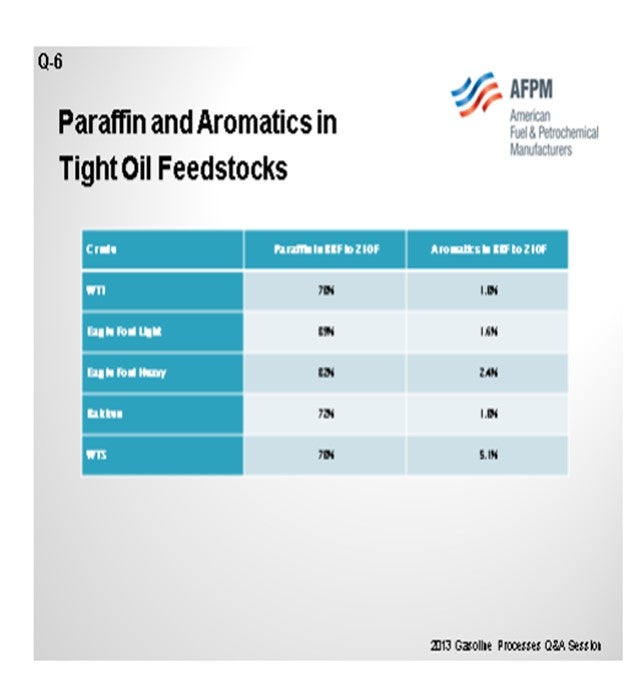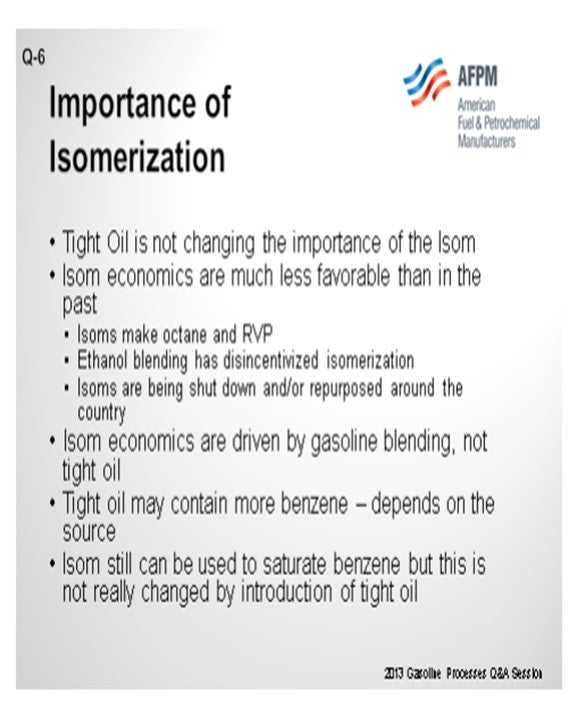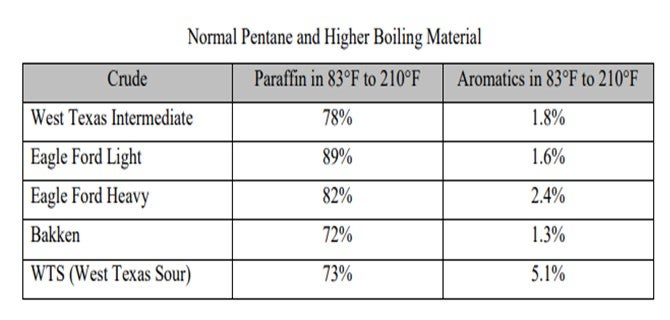Question 6: Has isomerization become more important as feedstocks have become more paraffinic with the increased processing of ‘tight oil’ feedstocks? Do ‘tight oil’ feedstocks contain more benzene?
ADAMS (HollyFrontier Corporation)
For this question, I looked in our assay database at the light straight-runs since we spoke a little about isomerization then. Really, if you think about benchmark crudes like WTI (West Texas Intermediate) and WTS (West Texas Sour), and if you consider Bakken and some of the Eagle Ford crudes as tight oil crudes, then the only one that really pops out as being meaningfully different is the Eagle Ford Light or the Eagle Ford condensate that some people are running. This generalization is that, at least in light straight-runs, we have a much higher paraffin in that stream. I am not sure I am seeing it. The one caveat I will make is that those WTI and WTS assays are fairly recent. Since they are blended crudes, there might already be a fair amount of that material in those streams.
There is really not meaningfully different amount of benzene in the tight oil crudes versus the WTI that we see. As far as the importance of isomerization, if your naphtha does, in fact, have less N+A in it and the reformer performance is dropping off, then you will have to make up that octane somewhere, or make less gasoline, or do something different with crude selection. So the answer for isomerization is sort of yes. Isomerization is nice because it does work on the paraffins. The motor octane is relatively high, and it polishes off benzene. We have isomerization at a number of our plants. We look at it as benzene polisher plus some octane improvement.

STREIT (KBC Advanced Technologies, Inc.)
I think, in general, the economic value of an isomerization unit (Isom) is not really changing that much with the presence of tight oil. The reformers typically have the capability of making up the octane because of what I mentioned before with the ethanol blending. Of course, the problem with isomerization units is that they make octane, but they also make RVP (Reid Vapor Pressure). So as RVP has gotten more restrictive, the value of isomerization units has generally gone down. Many units are being shut down or repurposed around the country. Tight oil may or may not contain more benzene. Isomerization units still have a value for destroying or saturating benzene, but it is not really significantly impacted by the presence of tight oil.

STEVE BAKAS (GE Water & Process Technologies)
Eric, you mentioned that in reforming, there are contaminants that may be of concern regarding tight oils. Do you see the same issue in isomerization?
STREIT (KBC Advanced Technologies, Inc.)
In general, yes. The contaminants are going to be in the naphtha range. How they are distributed between light and heavy I do not know for sure. Many places treat the whole naphtha together, so you do not really worry about that; just split it afterwards. Maybe one of these other guys has a better answer than that. I would tend to say that you still have the same concerns; but personally, I am used to looking at whole naphtha lately as opposed to light versus heavy and where the contaminants lie.
MARK ADAMS (HollyFrontier Corporation)
There does not appear to be a rule for paraffin concentration in light straight-run gasoline from ‘tight oil’ crudes except for the Eagle Ford condensate as shown below. Similarly, there does not appear to be a generalization you can make about benzene in ‘tight oil’ crudes

In either case, C5/C6 isomerization is an important process for reducing benzene in gasoline and increasing octane in the gasoline pool. The octane boost comes mostly from converting normal pentane 62 [RON and MON (motor octane number)] 16 RVP to isopentane 92 RON, 90 MON, and 20 RVP. The isomerate product is 83 to 84 RON. In the end, crude quality versus price guidance comes from the economic model as would the incentive to debottleneck the isomerization unit given expected relative values of light crudes.
ERIC STREIT (KBC Advanced Technologies, Inc.)
Isomerization, in itself, has become increasingly less desirable over recent times due to the mandate to increase ethanol in gasoline and the restrictive RVP specifications on finished gasoline. Isomerization units increase octane, which is worth less than it used to be, and increase RVP, which is a major constraint. As a result, isomerization unit economics have suffered greatly. Numerous isomerization units are run at highly reduced rates or shut down completely.
One area in which isomerization units are useful is in saturating benzene. As restrictions on benzene in gasoline have increased, refiners have taken many steps to reduce benzene. One way to reduce benzene is to feed it to an isomerization unit. Not only will the benzene be saturated in the isomerization unit, but many benzene precursors are removed from reformer feed in the process.
The benzene content of tight oil varies with the source. Some tight oils may contain higher levels of benzene, but this depends on the tight oil and the conventional oil to which it is being compared. Isomerization units will continue to have value in reducing the gasoline benzene content, but their value is not significantly affected by the addition of tight oils to the crude mix.
SONI OYEKAN (Prafis Energy Solutions)
The importance of isomerization units for oil refiners, as naphtha feedstock becomes more paraffinic with increased processing of ‘tight oil’ crudes, is highly dependent on refiners’ configuration of naphtha processing units and whether the refiner had elected to use pre-fractionation and/or post-fractionation for meeting low benzene gasoline production across its refineries. Those with multiple refineries and varying configurations of naphtha processing units have broader capabilities and flexibilities for producing a range of gasoline grades and benzene within limits.
The refiners with significant naphtha processing capabilities and who use C5/C6 or mixed C4 through C6 isomerization units have the flexibility to send more of the paraffinic naphtha feed to reformers to produce more reformate octane barrels. The amount of reformate octane barrels produced is dependent on the degree of optimization of the quality of the naphtha feed to the reformer. Isomerization units provide much needed flexibility for upgrading low light naphtha octane fractions and lowering overall refinery reformate and isomerate benzene. The importance of isomerization units is highly dependent on the naphtha processing flexibilities of the refiners. In addition, with potential future regulations for lower total aromatics in gasoline, oxygenate blending, isomerization, and alkylation, units would become increasingly more important for meeting regular and premium gasoline octane blends.